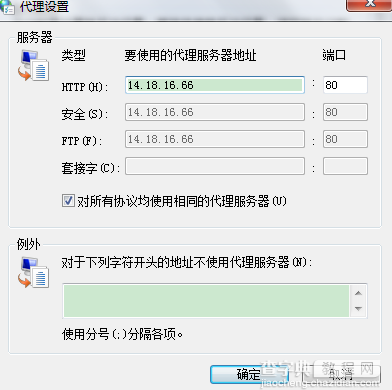1 前言
有时候我们的程序中要提供可以使用代理访问网络,代理的方式包括http、https、ftp、socks代理。比如在IE浏览器设置代理。

那我们在我们的java程序中使用代理呢,有如下两种方式。直接上代码.
2 采用设置系统属性
import java.net.Authenticator; import java.net.PasswordAuthentication; import java.util.Properties; public class ProxyDemo1 { public static void main(String[] args) { Properties prop = System.getProperties(); // 设置http访问要使用的代理服务器的地址 prop.setProperty("http.proxyHost", "183.45.78.31"); // 设置http访问要使用的代理服务器的端口 prop.setProperty("http.proxyPort", "8080"); // 设置不需要通过代理服务器访问的主机,可以使用*通配符,多个地址用|分隔 prop.setProperty("http.nonProxyHosts", "localhost|192.168.0.*"); // 设置安全访问使用的代理服务器地址与端口 // 它没有https.nonProxyHosts属性,它按照http.nonProxyHosts 中设置的规则访问 prop.setProperty("https.proxyHost", "183.45.78.31"); prop.setProperty("https.proxyPort", "443"); // 使用ftp代理服务器的主机、端口以及不需要使用ftp代理服务器的主机 prop.setProperty("ftp.proxyHost", "183.45.78.31"); prop.setProperty("ftp.proxyPort", "21"); prop.setProperty("ftp.nonProxyHosts", "localhost|192.168.0.*"); // socks代理服务器的地址与端口 prop.setProperty("socksProxyHost", "183.45.78.31"); prop.setProperty("socksProxyPort", "1080"); // 设置登陆到代理服务器的用户名和密码 Authenticator.setDefault(new MyAuthenticator("userName", "Password")); } static class MyAuthenticator extends Authenticator { private String user = ""; private String password = ""; public MyAuthenticator(String user, String password) { this.user = user; this.password = password; } protected PasswordAuthentication getPasswordAuthentication() { return new PasswordAuthentication(user, password.toCharArray()); } } }
3 使用Proxy
import java.io.BufferedReader; import java.io.InputStreamReader; import java.net.Authenticator; import java.net.HttpURLConnection; import java.net.InetSocketAddress; import java.net.PasswordAuthentication; import java.net.Proxy; import java.net.URL; public class ProxyDemo2 { public static void main(String[] args) throws Exception { URL url = new URL("http://www.3lai8.com"); // /创建代理服务器 InetSocketAddress addr = new InetSocketAddress("192.168.0.254", 8080); // Proxy proxy = new Proxy(Proxy.Type.SOCKS, addr); // Socket 代理 Proxy proxy = new Proxy(Proxy.Type.HTTP, addr); // http 代理 Authenticator.setDefault(new MyAuthenticator("username", "password"));// 设置代理的用户和密码 HttpURLConnection connection = (HttpURLConnection) url.openConnection(proxy);// 设置代理访问 InputStreamReader in = new InputStreamReader(connection.getInputStream()); BufferedReader reader = new BufferedReader(in); while (true) { String s = reader.readLine(); if (s != null) { System.out.println(s); } } } static class MyAuthenticator extends Authenticator { private String user = ""; private String password = ""; public MyAuthenticator(String user, String password) { this.user = user; this.password = password; } protected PasswordAuthentication getPasswordAuthentication() { return new PasswordAuthentication(user, password.toCharArray()); } } }
4 总结
OK,就这么的简单,搞定,用第一种方式是一种全局的代理,用第种方式可以针对具体的哪一个使用代理。知道了这些我们就可以做我们想做的事情了哦!
【分享java中设置代理的两种方式】相关文章:
